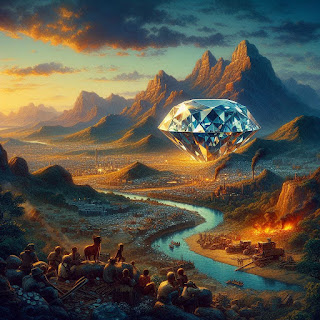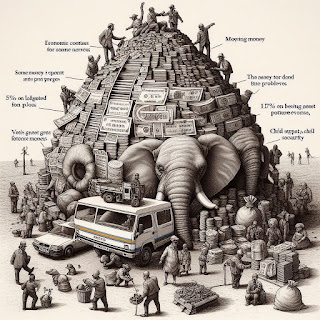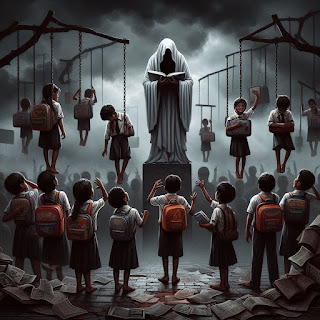Beyond Brilliance: Exploring Diamonds' Dark Side in South Africa
A diamond is forever!
You must remember this ad.
Diamond is one of the most precious jewels
in the world,
and the one who has a diamond
is the king of the world.
This equation is quite correct,
but there is a country that
was destroyed by these diamonds.
We are talking about South Africa.
And not just diamonds,
South Africa is the world's largest
producer of gold, chrome, manganese,
platinum, and is also
the world's 5th largest diamond producer,
yet the people there are poor.
Why so?
If you search about South Africa
on Google,
you will see such beautiful views,
but this is just for show.
From within, South Africa is full of
racism, inequality, poverty,
unemployment, and all such problems.
Let us understand about the economy
of South Africa.
Chapter One: History of
South Africa.
The history of South Africa
is quite interesting because
this country was colonized
not just once but twice.
Why and how?
Let us understand.
The British were colonizers.
They colonized many countries like India,
but other countries of Europe
were also as cruel as the British.
The Spanish, the French, the Portuguese,
all these countries would capture
another country
and plunder their natural resources,
and then leave them poor.
This formula was invented
by the whole of Europe
and mastered by the British,
but the wounds of colonization
still hurt the whole world.
South Africa is a living example of this.
In the 17th century, Dutch ships traveled
from the Netherlands to South Africa.
Their target was also to reach India.
The name of this company was also
Dutch East India Company.
In 1647, one of their ships was destroyed
near the coast of South Africa.
Its sailors were left with no option
other than farming
on the peak of South Africa.
After some time
these sailors were rescued.
They reported that
India is difficult to find
but South Africa is a good resting spot.
There is a lot of area here
where farming can be done,
so we can do farming here
for the coming journey.
This sinking boat of Dutch sailors
was sure to sink South Africa
in the times to come.
Employees of the Dutch East India Company
started farming on South African land.
They also started a trading outpost
in the Cape Town area
so that they could trade
with passing ships.
Look at the South African cricket team,
don't their names seem strange?
Van der Dussen, Du Plessis, De Kock,
all these names highlight
their Dutch history.
In fact, many cricketers playing
from the Netherlands today were also born
in South Africa.
The Netherlands and South Africa have
a special connection.
The Netherlands changed
the demography of South Africa.
Today, people from Madagascar,
East Africa, and even Indonesia
are seen here because Dutch traders
brought them as slaves to South Africa.
The employees of
the Dutch East India Company
started settling in South Africa
after their contracts ended.
They were given the name Vrijburghers.
Vrijburghers means free citizens.
This was the first colonization
of South Africa.
Now coming to the second colonization.
The British occupied South Africa in 1806.
Here there were not only African tribals
but also Free Burghers
who were against the British,
they also wanted to run away from
the atrocities of the British.
Then they slowly started moving
towards the North.
The British fought several wars
against the local tribes and the Dutch,
and eventually, they gained control
over the entire South Africa.
South Africa was then known
as the Cape Colony.
Chapter 2: A Diamond's
Curse.
European countries had no interest
in South Africa at all.
They wanted to trade with India.
South Africa was just a resting stop,
but in 1867 diamonds were found there
and the fortune of this country changed.
There was a revolution in South Africa
which is also called
the Mineral Revolution,
and this Mineral Revolution transformed
South Africa from an agrarian tribal area
to an industrialized nation.
They needed strong and powerful slaves
of good build to work in the mines.
When diamonds were found
for the first time in a town named
Kimberley,
prospectors started coming there
in great numbers.
Everyone wanted to try their luck.
When people found surface diamonds,
they had to dig deeper,
and for deeper excavation
they needed machines.
Steam powered machines,
and more advanced technology,
all this was not available
with the normal labor,
and then South Africa's mining industry
began to be controlled
by a few corporations.
Whoever had money, bought big machines
and started controlling the mines.
Big companies started acquiring
small mines.
You must've heard the name of the company,
DeBeers,
or must have seen their ads at least.
A diamond is forever.
DeBeers bought all the mines
in the Kimberley area.
In fact, when DeBeers founder Cecil Rhodes
died in 1902, DeBeers controlled
90% of the world's diamond supply.
These companies would pay very low wages
to laborers to increase their profits.
Machine operators got higher salaries
and ordinary laborers got lower salaries.
In fact, DeBeers began to feel that
their laborers were smuggling diamonds
into the black market,
so they set up strip clubs.
No, these are not the strip clubs
you are thinking of.
In these strip clubs,
laborers were stripped and searched
to check whether they had stolen diamonds,
and the company itself
would provide accommodation.
Basically, from then onwards segregation
i.e. discrimination had started.
At the same time, the number of workers
working in these mines was increasing,
and hence the demand for infrastructure,
food, and all these things
was also increasing.
But some mines were on people's farms,
and mining companies had bought
the farms of many people,
so there were food shortages.
To sort out the food shortages,
different capitalists bought farms
and commercialized farming.
Farmers started growing cash crops
such as sugarcane, coffee,
tobacco, and cotton.
During this time, the local population
started having wars with the British,
and after these wars,
the British started bringing their laws
to their Cape Colony.
Finally, after many protests,
South Africa became
the Union of South Africa in 1910.
After this, the Natives Act of 1913
was passed in which it was written
that the local black population
could not own land there.
Racial segregation was properly legalized
in 1948.
People were classified into 3 categories,
whites, blacks,
Indians and colored people.
This is called apartheid.
Whites had all the rights,
they owned most of the properties,
lived in good areas,
and got all the facilities.
At this point, I have something vital
to discuss with you,
and that is the White Man's Burden,
which means that white people have
a God-given duty.
They believe that God has made them
superior to other people,
and this is seen
in the case of South Africa as well.
White people majorly owned
mining companies.
So basically the logic was that
you can take anything from non-whites.
After all their resources are not theirs,
they belong to you,
and you can become rich by using them.
There is no question of
right and wrong in this.
No matter how wrong it may seem,
it is the white man's burden
to improve the world
and do whatever is necessary for that.
This model is seen
in many other countries too,
but it went to an extreme level
in South Africa.
Due to racial segregation,
whites and non-whites
were treated differently.
They were allowed to live
in different areas.
White people lived in posh areas,
and everyone else lived in slums.
Many international sanctions were imposed
on South Africa to end this apartheid.
And finally in 1994,
they removed all the laws
of racial segregation.
Chapter 3: The post-
apartheid world.
The story of South Africa
is like a diamond.
A diamond seems very valuable,
but both coal and diamond
are made of carbon.
At least electricity is generated
by burning coal,
but what is the use of diamond,
what is the value of diamond?
Marketing of diamonds
is the value of a diamond.
There is no real use of diamonds
except for a few industries,
but the marketing of diamonds is so strong
that is why the price of diamonds
keeps increasing.
After the end of apartheid in 1994,
the African National Congress party
came to power.
People thought that this party
would change everything.
People with whom bad things happened
will now get justice.
Society will finally become more equal.
But just like South African cricket team
chokes in crucial moments,
this country South Africa
also chokes in crucial moments.
Today's South Africa is like a diamond
but this diamond does not shine.
Why?
Because South Africa is
as segregated today as it was before.
Their unemployment rate is around 35%,
and the youth unemployment rate
is around 60%.
Crime is rampant in the country,
so much so that every house has
an electric fence,
it is impossible to live without it.
There's still 12 hours of load shedding
in South Africa,
and it's worse, especially in rural areas.
The demand for power here is high
and the supply is very low.
At the same time,
due to the high crime rate,
there are thefts in power stations,
so their funds go towards rectifying
the deficiency.
Nelson Mandela is considered
the hero of South Africa.
He fought against apartheid.
But his party ANC
has become corrupt today.
It runs almost 700 state-owned companies,
and fills its pockets due to corruption.
Now you must be wondering
what is the relation of all this
with economics.
Come on, it's time for Economics 101.
Let me explain to you a concept
called budget.
It seems quite simple
but it has far-reaching impacts.
A budget means
a list of expenses and income.
Every entity, whether it is a person,
a company, or a country, has some income.
Money comes in from some sources,
and the same money is spent
at different places.
Some money is also invested
for future use.
Money is allocated for every work.
But when it comes to problems,
it is important to think about
why the problems are not being solved
despite paying money.
South Africa spends 5% of its budget
on economic infrastructure,
5% on police forces,
13% on basic education,
17% on various grants, child support,
and social security,
but the results are not visible.
This means that corrupt politicians
do embezzlement.
Chapter 4: Lessons for
India.
All the problems of South Africa are
like a maze.
The majority of the black population
is poor because of old apartheid policies,
but the majority of business owners,
majority of land owners,
are all white people.
If poverty is to be reduced in the country
then basic facilities will have to be
provided to the people.
Clean drinking water,
good quality education,
uninterrupted power supply,
so that people can increase their skills
and take new jobs
or start some business themselves.
But in South Africa,
there are 12-12 hours of power cuts.
The power supply is so unreliable that
businesses are unable to operate properly.
As a result, the unemployment rate
in the country is high.
The crime rate is high
due to high unemployment.
When the African National Congress
was elected, they promised that
the rules of apartheid would be canceled,
there would be progress in South Africa,
and they would erase the impact
of the apartheid policy,
but they turned out to be corrupt.
They started filling their own pockets
with everything,
and the common people of the country
had to suffer the loss due to this.
This is a maze
and South Africa is stuck in it.
The tragic thing is that
many of these problems
are preventable problems.
According to a government report,
South Africa's demand was increasing
but their electricity surplus
was going to last only till the year 2007,
after which they would have to
increase power generation.
But there is no competition
in the electricity sector,
hence decisions were not taken
at the right time.
And earlier the country that used to
sell surplus power to other countries,
today the same country is bearing
load shedding for 12-12 hours.
Power demand is increasing in India too,
but every few months we read news
that there is a coal shortage.
We are taking big steps
in renewable energy,
but still, the majority is dependent
on coal.
Solar power produces
only 6% of electricity.
In fact, recently load shedding took place
in Pune during Diwali.
We need reforms in the electricity sector,
and that too urgently.
South Africa is a reminder to us that
while per capita GDP is important,
it can also be misleading.
The per capita GDP of South Africa
is 6,776 dollars
and that of India is 2,388 dollars.
But looking at these numbers,
it cannot be said that a common person
in South Africa is 3 times richer than us
because all the wealth is concentrated
in the hands of a few people.
South Africa is one of
the most unequal countries in the world.
The Gini coefficient measures inequality
in society
i.e. how much difference there is
between rich and poor.
The Gini coefficient of
South Africa is 0.6.
For context, India's is 0.35.
In this coefficient,
a value of 0 means a highly equal society
and 1 means a highly unequal society.
This means South Africa is
a very unequal society,
and this is reflected in
the rest of their indicators as well.
If you got value from this blog,
and learned something new,
then share it with your friends,
When seen from a distance, it seems that
every country except India is perfect,
there are so many wonderful
scenes and views everywhere,
but the truth is that
no country is perfect,
it has to be made perfect.
And conveying this important thing
to you matters to me.
Friends, thank you so much for reading
this blog till the end.
If you liked this blog then press
the like button.
Thank you so much for reading.
because your support matters to us.





















Comments
Post a Comment